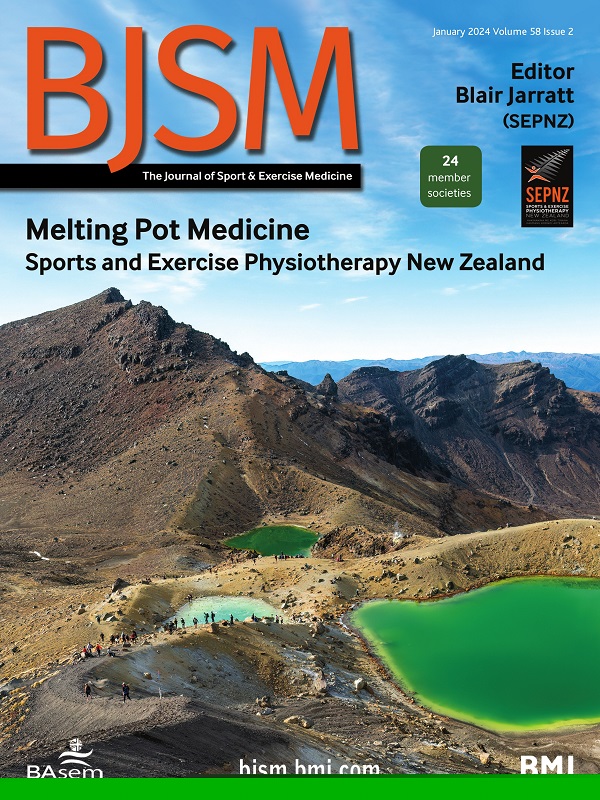在一个赛季的铲球技术指导干预后,精英级女子橄榄球联赛中头部接触率降低。
IF 16.2
1区 医学
Q1 SPORT SCIENCES
引用次数: 0
摘要
在女子橄榄球联盟(n=12支球队)中,我们(1)确定了由运动伙伴(如运动员、教练、比赛官员)告知的头部接触的修饰语;(2)在一个赛季的铲球技术指导干预后,比较了前两个赛季的头部接触和脑震荡率;(3)探讨了干预的障碍和促进因素。方法采用多方法设计。第1部分:体育合作伙伴通过审查头对头接触的录像确定了缓解策略,为制定针对教练的铲球技术干预提供了信息。第2部分评估干预措施,比较头部接触和脑震荡发生率(IRs)。对教练和球员的访谈(n=6)探讨了有效实施和遵守干预措施的障碍和促进因素。结果体育合作伙伴报告说,铲球者对头对头接触更负责,降低铲球高度是干预前和干预后最常建议的缓解策略。干预期间,头部接触率显著低于干预前(IR 59;95% CI 56 ~ 62, IR 28;95%置信区间为25 - 30/1000);然而,脑震荡的发生率没有差异。干预的障碍包括球员的身体和技术基础不发达,缺乏对干预及其目的的认识和理解,以及女子橄榄球联盟的环境背景和资源缺乏。对铲球和脑震荡后果的信念被视为障碍和推动因素。结论患者头-头接触率显著降低;然而,在铲球技术指导干预后,脑震荡的发生率并没有降低。头部接触的减少可能是由于对减少头部损伤的关注增加以及球员/教练意识和支持的增加。本文章由计算机程序翻译,如有差异,请以英文原文为准。
Reduced head-to-head contact rates in elite-level women's rugby league following a season-long tackle technique coaching intervention.
OBJECTIVE
Within women's rugby league (n=12 teams), we (1) identified modifiers for head-to-head contacts informed by sport partners (eg, players, coaches, match officials); (2) compared head-to-head contact and concussion rates to the previous two seasons following a one-season tackle technique coaching intervention and (3) explored barriers and enablers of the intervention.
METHODS
A multi-method design was used. Part 1: Mitigation strategies were identified by sport partners reviewing footage of head-to-head contacts, informing the development of a coach-targeted tackle technique intervention. Part 2 evaluated the intervention, comparing head-to-head contact and concussion incidence rates (IRs). Interviews with coaches and players (n=6) explored barriers and enablers to effective implementation and compliance with the intervention.
RESULTS
Sport partners reported tacklers were more responsible for head-to-head contacts and lowering the tackle height was the most frequently suggested mitigation strategy preintervention and postintervention. Head-to-head contact rates were significantly lower during the intervention than preintervention (IR 59; 95% CI 56 to 62 vs IR 28; 95% CI 25 to 30/1000 tackle events); however, concussion rates showed no difference. Perceived barriers to the intervention included underdeveloped physical and technical foundations of players, lack of knowledge and understanding of the intervention and its purpose, and the environmental context and lack of resources in women's rugby league. Beliefs about the consequences of the tackle and concussion were perceived as barriers and enablers.
CONCLUSIONS
Head-to-head contact rates were significantly lower; however, concussion rates did not decrease following a tackle technique coaching intervention. Reduced head-to-head contacts are potentially due to an increased focus on head injury reduction and increased player/coach awareness and support.
求助全文
通过发布文献求助,成功后即可免费获取论文全文。
去求助
来源期刊
CiteScore
27.10
自引率
4.90%
发文量
217
审稿时长
3-8 weeks
期刊介绍:
The British Journal of Sports Medicine (BJSM) is a dynamic platform that presents groundbreaking research, thought-provoking reviews, and meaningful discussions on sport and exercise medicine. Our focus encompasses various clinically-relevant aspects such as physiotherapy, physical therapy, and rehabilitation. With an aim to foster innovation, education, and knowledge translation, we strive to bridge the gap between research and practical implementation in the field. Our multi-media approach, including web, print, video, and audio resources, along with our active presence on social media, connects a global community of healthcare professionals dedicated to treating active individuals.

 求助内容:
求助内容: 应助结果提醒方式:
应助结果提醒方式:


